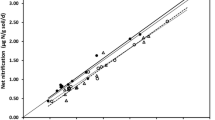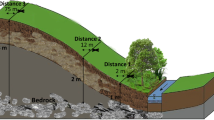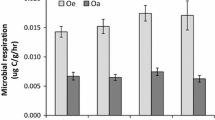Abstract
Nitrate leaching occurs when the soil's nitrogen immobilisation and plant uptake capacity has been saturated. Several widely-used models of nitrogen saturation incorporate a breakthrough function in which N begins to be leached at C/N values below an upper threshold, and is completely leached at C/N values below a lower threshold. In a survey of deciduous and coniferous woodland, acid grassland and heathland sites for which both C/N and nitrate flux measurements were available, deciduous woodland and acid grassland typically had lower C/N ratios, and began leaching nitrate at a lower C/N ratio, than coniferous woodland and heathland. Least-square fits of nitrate breakthrough functions gave upper thresholds (no nitrate leaching) of 27 mol C mol−1 N for deciduous woodland and acid grassland and 50 mol C mol−1 N for coniferous woodland and heathland. Upper thresholds were similar, at 24 and 51 mol C mol−1 N, respectively, for total inorganic N (NH4 + NO3) leaching flux as a proportion of total inorganic N influx. In conifer plantations, stand maturity had a large effect, suggesting that a breakthrough function is unsuitable for modelling systems that are in disequilibrium. However, there was sufficient evidence to suggest that using different breakthrough C/N thresholds for different groups of vegetation would improve predictions of N saturation and leaching at both plot and catchment scales. The difference may be related to the reactivity of soil carbon; soils with a large proportion of recalcitrant carbon are likely to begin leaching nitrate at a higher C/N value than soils with more labile carbon.
Similar content being viewed by others
References
Aber, J. D., Ollinger, S. V., & Driscoll, C. T. (1997). Modeling nitrogen saturation in forest ecosystems in response to land use and atmospheric deposition, Ecological Modelling, 101, 61–78.
Aber, J. D., McDowell, W., Nadelhoffer, K. J., Magill, A., Berntson, G., Kamakea, M., McNulty, S., Currie, W., Rustad, L., & Fernandez, I. (1998). Nitrogen saturation in temperate forest ecosystems: Hypotheses revisited, Bioscience, 48, 921–934.
Avery, B. W. (1980). Soil classification for England and wales (Higher Categories). Soil Survey Technical Monograph No. 14, 66 pp.
Batjes, N. H. (1996). Total carbon and nitrogen in soils of the World. European Journal of Soil Science, 47, 151–163.
Broadmeadow, M., Kennedy, F., Vanguelova, E., Broadmeadow, S., Pitman, R., Crow, P., & Griffiths, M. (2004). Terrestrial umbrella: Eutrophication and acidification of terrestrial ecosystems: Final report, Forest Research, 24 pp.
Coleman, K., Jenkinson, D. S., Crocker, G. J., Grace, P. R., Klir, J., Korschens, M., Poulton, P. R., & Richter, D. D. (1997). Simulating trends in soil organic carbon in long-term experiments using rothC-26.3, Geoderma, 81, 29–44.
Cosby, B. J., Ferrier, R. C., Jenkins, A., & Wright, R. F. (2001). Modelling the effects of acid deposition: Refinements, adjustments and inclusion of nitrogen dynamics in the magic model, Hydrology and Earth System Sciences, 5, 499–517.
Curtis, C., & Simpson, G. (2001). Summary of research under DETR contract. Acidification of freshwaters: The role of nitrogen and the prospects for recovery EPG/1/3/117, Environmental Change Research Centre, University College London, 26 Bedford Way, London WC1H 0AP, 149 pp.
Curtis, C. J., Emmett, B. A., Reynolds, B., & Shilland, E. (2004). Nitrate leaching from Moorland soils: Can soil C:N ratios indicate N saturation?, Water Air and Soil Pollution: Focus, 4, 359–369.
Curtis, C. J., Emmett, B. A., Reynolds, B., & Shilland, J. (In press). Denitrification as a Sink for atmospherically deposited nitrogen in UK Moorlands, Soil Biology and Biochemistry.
Dise, N. B., & Wright, R. F. (1995). Nitrogen leaching from European forests in relation to nitrogen deposition, Forest Ecology and Management, 71, 153–161.
Dise, N. B., Matzner, E., & Forsius, M. (1998). Evaluation of organic horizon C:N ratio as an indicator of nitrate leaching in conifer forests across Europe, Environmental Pollution, 102, 453–456.
Dore, A., Heywood, E., Vieno, M., Fournier, N., Smith, R., Weston, K., Hall, J., & Sutton, M. A. (2003), Modelling the transport and deposition of sulphur and reduced and oxidised nitrogen in the UK, Centre for Ecology and Hydrology, Edinburgh.
Emmett, B. A., Reynolds, B., Stevens, P. A., Norris, D. A., Hughes, S., Gorres, J., & Lubrecht, I. (1993). Nitrate leaching from afforested welsh catchments – interactions between stand age and nitrogen deposition, Ambio, 22, 386–394.
Emmett, B. A., Cosby, B. J., Ferrier, R. C., Jenkins, A., Tietema, A., & Wright, R. F. (1997). Modelling the ecosystem effects of nitrogen deposition: Simulation of nitrogen saturation in a sitka spruce forest, Aber, Wales, UK, Biogeochemistry, 38, 129–148.
Emmett, B. A., & McShane, G. (2004). Terrestrial umbrella: Final report May 2004. Centre for Ecology and Hydrology, Bangor, UK, 390 pp.
Evans, C. D., & Reynolds, B. (2003). An assessment of the suitability of the very simple dynamic (VSD) model for UK national-scale application: Model and data issues. Centre for Ecology and Hydrology, Bangor. CEH Contract No: C01837. Report to DEFRA under Contract No. EPG 1/3/186, 27 pp.
Evans, C. D., Smart, S. M., Scott, W. A., Whittaker, J. A., Langan, S. J., Emmett, B. A., & Ashmore, M. R. (2004). Task 2: Evaluation and development of dynamic models for soils and soil-plant systems. In B. A. Emmett, & G. McShane (Eds.), Terrestrial Umbrella Final Report. pp. 9–122.
Evans, C. D., Reynolds, B., Jenkins, A., Helliwell, R. C., Curtis, C. J., Ferrier, R. C., Goodale, C. L., Emmett, B. A., Pilkington, M., Caporn, S. J. M., Carroll, J. A., Norris, D., Davies, J., & Coull, M. C. (In press). Evidence that soil carbon pool determines susceptibility of semi-natural ecosystems to elevated nitrogen leaching, Ecosystems.
Gundersen, P., Callesen, I., & de Vries, W. (1998). Nitrate leaching in forest ecosystems is related to forest floor C/N ratios, Environmental Pollution, 102, 403–407.
Kristensen, H. L., Gundersen, P., Callesen, I., & Reinds, G. J. (2004). Throughfall nitrogen deposition has different impacts on soil solution nitrate concentration in european coniferous and deciduous forests, Ecosystems, 7, 180–192.
Kros, J., Tietema, A., Mol-Dijkstra, J. P., & de Vries, W. (2004). Quantification of nitrate leaching from forest soils on a national scale in the Netherlands, Hydrology and Earth System Sciences, 8, 813–822.
Lawes Agricultural Trust. (2005). Genstat – Eighth Edition., VSN International Ltd. http://www.vsn-intl.com/
Lovett, G. M., Weathers, K. C., & Arthur, M. A. (2002). Control of nitrogen loss from forested watersheds by soil carbon: Nitrogen ratio and tree species composition, Ecosystems, 5, 712–718.
MacDonald, J. A., Dise, N. B., Matzner, E., Armbruster, M., Gundersen, P., & Forsius, M. (2002). Nitrogen input together with ecosystem nitrogen enrichment predict nitrate leaching from european forests, Global Change Biology, 8, 1028–1033.
Magill, A. H., Aber, J. D., Currie, W. S., Nadelhoffer, K. J., Martin, M. E., McDowell, W. H., Melillo, J. M., & Steudler, P. (2004). Ecosystem response to 15 years of chronic nitrogen additions at the harvard forest LTER, Massachusetts, USA, Forest Ecology and Management, 196, 7–28.
MathWorks. (2005). Matlab. http://www.mathworks.com/.
Matzner, E., & Grosholz, C. (1997). Beziehungen Zwischen NO3 - – Austrägen, C/N-Verhältnissen der Auflage und N-Einträgen in Fichtenwald ( Picea abies Karst.)-ökosystemen Mitteleuropas. Forstw. Cbl., 116, 39–44.
NCC, (1990). Handbook for Phase 1 Habitat Survey: A Technique for Environmental Audit. Nature Conservancy Council, Peterborough, England, 62 pp.
Neff, J. C., Townsend, A. R., Gleixner, G., Lehman, S. J., Turnbull, J., & Bowman, W. D. (2002). Variable effects of nitrogen additions on the stability and turnover of soil carbon, Nature, 419, 915–917.
Parton, W. J., Stewart, W. J., & Cole, C. V. (1988). Dynamics of C, N, P and S in grassland soils: A model, Biogeochemistry, 5, 109–131.
Posch, M., & De Vries, W. (1999). Derivation of critical loads by steady-state and dynamic soil models. In S. J. Langan (Ed.), The impact of nitrogen deposition on natural and semi-natural ecosystems, Dordrecht, The Netherlands: Kluwer Academic Publishers, pp. 213–234.
Posch, M., & Reinds, G. J. (2005). VSD – User manual of the very simple dynamic soil acidification model. Coordination Centre for Effects, RIVM, Bilthoven, The Netherlands.
Reynolds, B., Emmett, B. A., Norris, D. A., & Stevens, P. A. (1995). Critical loads for nitrogen in upland conifer plantations: Final report. Institute of Terrestrial Ecology (Natural Environmental Research Council), Bangor Research Unit, Deiniol Road, Bangor, Gwynedd, LL57 2UP, UK, 96 pp.
Rothe, A., & Mellert, K. H. (2004). Effects of forest management on nitrate concentrations in seepage water of forests in southern bavaria, Germany, Water Air and Soil Pollution, 156, 337–355.
Williams, D. L., Emmett, B. A., Brittain, S. A., Pugh, B. S. H., Norris, D., Meadows, K., Richardson, C., & Bell, S. (2000). Influence of forest type, structure and management on nitrate leaching, Centre for Ecology and Hydrology, Monks Wood, Abbots Ripton, Huntingdon, PE28 2LS, UK, 56 pp.
Author information
Authors and Affiliations
Corresponding author
Rights and permissions
About this article
Cite this article
Rowe, E.C., Evans, C.D., Emmett, B.A. et al. Vegetation Type Affects the Relationship Between Soil Carbon to Nitrogen Ratio and Nitrogen Leaching. Water Air Soil Pollut 177, 335–347 (2006). https://doi.org/10.1007/s11270-006-9177-z
Received:
Accepted:
Published:
Issue Date:
DOI: https://doi.org/10.1007/s11270-006-9177-z




